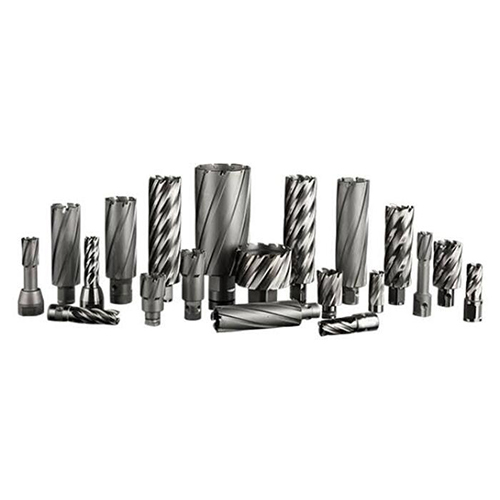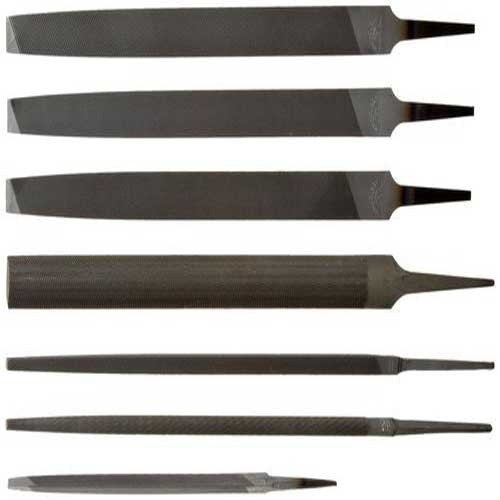Metal Alloy Files & Drills
PetroSan is India’s one of the largest high quality suppliers & Exporter of Steel files, quality Special metal steel files, Agriculture tools, rasps, filing tools & drilling rods to oversees market.
The most popular metal alloys used to make metal files and drills are cobalt steel, tungsten carbide, high-carbon steel, and High-Speed Steel (HSS). The hardness, durability, heat resistance, and applicability of the tool for various materials are all determined by the alloy selection.


Metal alloys used for files
- High-carbon steel: This is the most common material for traditional hand files.
- It contains around 1.35–1.4% carbon, which enables the steel to become extremely hard and durable when heat-treated.
- Manufacturers harden and temper the steel to create tough cutting edges that are resistant to wear.
- High-carbon chrome alloy steel: Many hand files are made from high-carbon steel that is alloyed with chromium. The chromium increases the steel’s hardness and toughness, preventing it from cracking.
- Diamond files: For filing extremely hard materials like hardened steel, stone, or glass, files with industrial diamond grains embedded into their surface are used. These are far more abrasive and effective than standard steel files for these applications.
Metal alloys used for drills
- High-Speed Steel (HSS): An affordable and versatile material, HSS is used for general-purpose drilling of softer materials like wood, plastic, and mild steel.
- HSS is more heat-resistant than standard carbon steel, allowing it to cut faster without losing its temper.
- Titanium-coated HSS: HSS bits can be coated with titanium nitride (TiN) to create a harder surface that reduces friction and increases durability.
- Black oxide-coated HSS: A black oxide finish provides corrosion resistance and increased durability.
- Cobalt steel (HSS-Co): This alloy is created by adding 5–8% cobalt to HSS.
- It offers significantly higher heat resistance and hardness, making it ideal for drilling tough metals like stainless steel, cast iron, and titanium.
- While more expensive than standard HSS, cobalt bits are also more durable and can be resharpened.
- Tungsten carbide: Known for extreme hardness, tungsten carbide is one of the toughest materials used for drills.
- These bits are ideal for the most demanding applications, including drilling through concrete, tile, masonry, and other extremely hard materials.
- Tungsten carbide bits are the most brittle and expensive option, so they are not used for general-purpose tasks.
- Carbide-tipped: Some drills, particularly masonry bits, have a carbide tip brazed onto a steel body. This provides the hardness of carbide where it’s needed while keeping the overall cost lower than a solid carbide bit
Metal alloy files
By cut (coarseness)
- Rough/Coarse Cut: Used for removing large amounts of material quickly during heavy-duty work.
- Bastard Cut: A medium-coarse cut used for general-purpose material removal.
- Second Cut: Provides a smoother finish than a bastard cut and is ideal for final shaping before smoothing.
- Smooth Cut: The finest standard cut, used for producing a high-quality, smooth surface finish.
- Dead Smooth Cut: The finest cut available, used for the most delicate finishing work.
By shape
- Flat File: Rectangular with teeth on the sides and edges, used for filing flat surfaces.
- Half-Round File: Has one flat side and one rounded side, making it suitable for both flat and curved surfaces.
- Round File (Rat-tail): Tapered and circular in cross-section, used for enlarging round holes and filing concave surfaces.
- Square File: Square in cross-section with teeth on all four sides, used for filing square holes and slots.
- Triangular File (Three-square): Triangular in cross-section, ideal for filing internal angles and sharpening saw teeth.
- Needle Files: Smaller, more delicate files that come in many shapes for precision work on jewelry, electronics, and other intricate projects.
By cutting pattern
- Single-Cut: Features a single row of diagonal teeth for a finer finish and lighter material removal.
- Double-Cut: Has two intersecting rows of teeth for faster, more aggressive material removal.
Metal alloy drills
By material composition
- High-Speed Steel (HSS): An all-purpose alloy suitable for drilling soft steel, wood, and plastic at high speeds. HSS maintains hardness at elevated temperatures, which is a major advantage in metalworking.
- HSS with Cobalt (HSS-Co or Cobalt): Contains a percentage of cobalt (typically 5–8%) for enhanced heat resistance and abrasion resistance. These bits are stronger than standard HSS and are ideal for drilling tough metals like stainless steel, cast iron, and titanium.
- Tungsten Carbide: Extremely hard and wear-resistant, solid carbide bits are used for demanding, heavy-duty applications and for drilling very hard materials.
- Titanium Coated: A finishing layer of titanium nitride on HSS bits adds hardness, reduces friction, and extends the bit’s life. However, unlike solid cobalt, the coating cannot be restored by resharpening.
- Carbide-Tipped: Bits with a carbide tip brazed onto a softer steel shank, often used for masonry drilling but also in metalworking for specific applications.
By geometry and design
- Twist Drill Bits: The most common type of drill bit, featuring a spiraled cutting edge (flute) to remove chips from the hole. Twist drills are available in HSS, cobalt, and carbide for general-purpose metal drilling.
- Step Drill Bits: These have a conical shape with multiple cutting edges at different diameters. They are useful for creating holes of various sizes in thin materials like sheet metal.
- Countersink Bits: Used to cut a conical, flared opening in a drilled hole so that a screw head can sit flush with the surface.
- Rotary Burrs (Rotary Files): Not a traditional drill, but a rotary cutting tool used in a die grinder or similar tool. Carbide burrs are used for shaping, deburring, and polishing metals, and come in many different shapes (e.g., cylindrical, spherical, conical)
Materials for files
- High-carbon steel: This is the traditional and most common material for manufacturing hand files.
- Properties: Its high carbon content allows it to be heat-treated to a very high hardness (such as HRC 62–64 for T12 steel), providing strong, durable, and wear-resistant cutting teeth.
- Example product: The BOSCH 5-Piece File Set
is made from durable carbon steel, suitable for metal crafting, deburring, and smoothing surfaces.
- Alloy steel: Files can also be made from other alloy steels, which often include additional elements like chromium for corrosion resistance.
- Example product: The Generic 2X100Mm Precision Steel Alloy Files Group Tool
is an alloy steel set advertised for metalworking.
- Example product: The
Materials for drills
- High-speed steel (HSS): An entry-level tool steel alloy that is durable and more heat-resistant than standard carbon steel.
- Properties: HSS is a cost-effective material suitable for drilling softer metals like iron, steel, and aluminum, as well as wood and plastic.
- Example product: The Bosch Professional Metal Drill Bit HSS PointTeQ
is an HSS spiral drill bit for fast drilling in metal.
- Cobalt steel alloy (HSS-Co): A variation of high-speed steel that contains a higher percentage of cobalt (typically 5–8%).
- Properties: The addition of cobalt increases heat resistance and hardness, making these bits ideal for drilling hard metals, including stainless steel and cast iron, at higher speeds.
- Example product: ILIKA High Speed Steel Burr Drill Bit Set
is a tool suitable for metal working, rasping, and cutting various materials.
- Solid carbide: These drill bits are made entirely of tungsten carbide, an extremely hard and brittle material.
- Properties: Solid carbide bits are used for precision drilling in very hard materials and for high-speed CNC applications. While more brittle, they hold an edge longer than steel bits.
- Carbide-tipped: These bits use high-speed steel for the shank and body but have a small tip of carbide brazed onto the end.
- Properties: This design provides the extreme hardness of carbide at the cutting edge while being more affordable and tougher than a solid carbide bit. These are often used for masonry and tile but also for some metal applications.
Tool steel coatings.
- Black oxide: This coating provides a rust-resistant finish and improves lubrication.
- Titanium Nitride (TiN): A gold-colored ceramic coating that reduces friction and increases the lifespan of HSS drill bits.
- Titanium Aluminum Nitride (TiAlN): Offers higher heat resistance than TiN, making it suitable for high-speed, high-temperature drilling.
- Diamond-coated: Provides excellent abrasion resistance for cutting hard and brittle materials like glass, tile, and ceramics
Petrosan oilfield engg. co. is one of the stockist, Supplier and exporters of Metal Alloy Flat File, Supplier and exporters of Half-Round File, Supplier and exporters of Round File (Rat-tail), Supplier and exporters of Square File, Supplier and exporters of Triangular File (Three-square), Supplier and exporters of Needle Files, Supplier and exporters of High-Speed Steel (HSS), Supplier and exporters of HSS with Cobalt (HS-Co or Cobalt), Supplier and exporters of Tungsten Carbide, Supplier and exporters of Titanium Coated, Supplier and exporters of Carbide-Tipped, Supplier and exporters of Twist Drill Bits, Supplier and exporters of Step Drill Bits, Supplier and exporters of Countersink Bits, Supplier and exporters of Rotary Burrs (Rotary Files).
We Manufacture, Export and supply to many Countries as follows :
- ASIA – India, Japan, Thailand, Singapore, Sri lanka, Bangladesh, South Korea, Indonesia, Philippines, Vietnam, Kazakhstan, Azerbaijan, Turkmenistan.
- Middle East – Kuwait, Dubai, Saudi Arabia, Qatar, Oman, Bahrain, Jordan, Turkey, Iraq, Yemen, Syria, Azerbaijan, United Arab Emirates, Israel.
- Western Europe – Germany, France, Netherlands, Belgium, Austria, Switzerland, Luxembourg, Monaco, Liechtenstein
- Eastern Europe – Russia, Ukraine, Poland, Romania, Czechia, Hungary,Belarus, Bulgaria, Slovakia, Moldova
- Northern Europe – United Kingdom, Sweden, Denmark, Finland, Norway, Ireland, Lithuania, Latvia, Estonia, Iceland, Isle of Man, Faeroe Islands
- Southern Europe – Italy, Spain, Greece, Portugal, Serbia, Croatia, Bosnia and Herzegovina, Albania, North Macedonia, Slovenia, Montenegro, Malta, Andorra, Gibraltar, San Marino, Holy See
- South America – Argentina, Chile, Brazil, Colombia, Paraguay
- Western Africa – Nigeria, Ghana, Côte dIvoire, Niger,Burkina Faso, Mali, Senegal, Guinea, Benin, Togo, Sierra Leone, Liberia, Mauritania, Gambia, Guinea-Bissau, Cabo Verde, Saint Helena
- Northern Africa – Egypt, Sudan, Algeria, Morocco, Tunisia, Libya, Western Sahara
- Southern Africa – South Africa, Namibia, Botswana,Lesotho, Swaziland
- Eastern Africa – Ethiopia, Tanzania, Kenya, Uganda,Mozambique, Madagascar, Malawi, Zambia, Zimbabwe, South Sudan, Rwanda, Burundi, Somalia, Eritrea, Mauritius, Djibouti, Réunion, Comoros, Mayotte, Seychelles.

